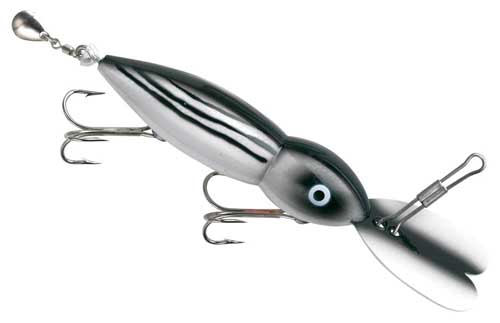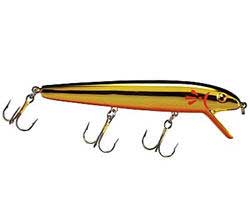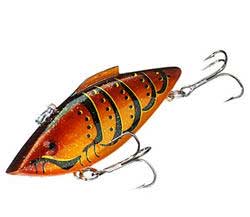 If you’ve ever hung a big landlocked striped bass on an artificial lure, you know it’s a jarring experience. There’s nothing tentative about the way a striper hits a surface plug, crankbait or jig — no slight peck, no mushy feeling, none of that maybe stuff. “How will you know when a fish strikes?” A striper doesn’t strike a lure, it creams it, smashes it with a vengeance, blows it to kingdom come.
If you’ve ever hung a big landlocked striped bass on an artificial lure, you know it’s a jarring experience. There’s nothing tentative about the way a striper hits a surface plug, crankbait or jig — no slight peck, no mushy feeling, none of that maybe stuff. “How will you know when a fish strikes?” A striper doesn’t strike a lure, it creams it, smashes it with a vengeance, blows it to kingdom come.

Most die-hard striper anglers rely on live bait 85% of the time. They may chunk topwaters or crankbaits at dawn and dusk, then snip them off and use bait for the remainder of the day.
Sure, live bait works great. But you can catch stripers all day long on artificials, too — even on days when they’re turning up their noses at shad or herring. We’ve classified various lure styles and gathered some inside tips on fishing ’em. Some of the lures we’ll mention may be familiar to you, others not. Try ’em and see if they don’t bring an exciting new dimension to your striper fishing.
Topwater Fishing Lures
Fish topwater lures anywhere you see stripers surfacing, which can include open water. Be sure to try them where these predators are most likely to intercept schools of bait — across the ends of reservoir points, on shallow flats, in protected coves, against bluff banks, in river eddies, etc.
As a rule of thumb, use the bigger, noisier topwater styles in low-light situations — at dawn and dusk, after dark, on rainy days and when the water is choppy. As light levels intensify, switch to a progression of quieter, more realistic lures, saving your most subtle and lifelike offerings for mid-day.
Prop Baits — These are the first lures to use at daybreak and the last ones to cast before darkness falls. They’re also good during the day if it’s stormy or rough. These are big-fish lures; if the stripers in your local waters run in excess of 20 pounds, ignore bass-sized prop baits with wimpy hooks and hardware and use big, stout ones like Luhr-Jensen’s Big Game Woodchopper (pictured).
- Inside tip: Stripers often strike these lures repeatedly without hooking up. If a fish blows up or rolls on the bait but misses it, twitch the lure gently, making the props barely sputter — she’ll come back and eat it.
Poppers — Favored by saltwater striper anglers for schooling fish, these noisy lures will work well on landlocks, too. Use them in low-light or choppy conditions. You can cast big saltwater poppers a country mile; this makes them useful when a striper school is in hot pursuit of bait and moving quickly.
- Inside tip: for some reason, poppers work better than any other topwater style in churning tailwater boils — even bank anglers catch monster fish on them.
 Surface Minnows — Easily the most popular of all landlocked striper lures, with the Cordell Red Fin (pictured) being the classic example. They can catch stripers in bright sunlight, but their best application is early and late in the day. Use a slow, swimming retrieve, keeping the rod tip high while reeling the lure just fast enough so it sashays back and forth across the surface, throwing a tell-tale wake behind it.
Surface Minnows — Easily the most popular of all landlocked striper lures, with the Cordell Red Fin (pictured) being the classic example. They can catch stripers in bright sunlight, but their best application is early and late in the day. Use a slow, swimming retrieve, keeping the rod tip high while reeling the lure just fast enough so it sashays back and forth across the surface, throwing a tell-tale wake behind it.
- Inside tip: Remove the hooks from a big surface minnow and scrape the paint off the lure body. This usually reveals bone white plastic underneath — this color is deadly on stripers! Replace the front hook, but substitute the rear hook for one a size larger. This sinks the tail slightly, allowing you to retrieve the lure faster while maintaining the right wake-throwing action — a real asset in clear water.
Stick Baits — Exceptionally good in moderate light. You’ll love ’em when morning fog begins to break up on reservoirs and tailwaters. The erratic “walk the dog” retrieve is hard to beat; use a short (under 6 foot) rod, point the rod tip to the water’s surface and snap the slack out of the line with a single downward stroke at the same time you turn the reel handle.
- Inside tip: on bright days, bass-sized stick baits like Heddon’s Zara Spook are often more deadly than larger saltwater styles. To help keep big stripers from pulling the hooks out of these baits, remove the screws holding the hook hangers, dip in epoxy cement and replace.
Soft Plastic Lures
Soft Jerkbaits — Incredibly realistic lures that will catch stripers from daybreak ’til dark. Especially deadly in shallow, gin-clear water where stripers may turn away from other artificials. Our favorites are Bass Pro Shops Stick-O worm or Lunker City’s 10-inch Fin-S Fish (pictured) and 9-inch Slug-Go; they perfectly capture the look and action of big forage fish upon which megastripers dine. Bass anglers fish soft jerk baits slowly; for clearwater stripers, try fishing ’em fast, darting, twitching and skipping ’em on or just under the surface. Inside tip : when rigging soft jerk baits, use the big worm hook that comes with the lure, but add a treble stinger. Stick the worm hook through the lure’s head, bring it out the bottom and simply run it through the eye of a big treble hook before reinserting it into the lure, so the treble hook dangles freely. This rigging will stick even those fish that slap at the lure without eating it.
Leadhead Trailers — Big twist-tail grubs like Kalin’s Mogambo top this list. Fish them on either bucktail (hair) jigs or plain leadheads. Try bucktails up shallow in early spring — they’re deadly in coves and long points when heavy rains have stained the water in a normally clear reservoir or river. Eel and shadtail trailers may be substituted for twisters; work these with a bottom-bumping or fast-twitch retrieve.
- Inside tip: in rivers and tailraces, stripers often use submerged trees as ambush points. Swim twisters through the ends of the branches; use heavy line for added abrasion resistance.
Tube Baits — The biggest examples of these lifelike lures are deadly for stripers. Consider them finesse lures — they don’t have the noise or frantic action of many other artificials and are best used when the bite is slow. Try rigging a big tube on a Carolina rig with a heavy sinker; fish this around reservoir points and river ledges to the 35-foot level. They can also be rigged on a saltwater leadhead and bumped along the bottom.
- Inside tip: Fill a big tube with Styrofoam peanuts so it’ll float, then fish it on a stout hook.
Spoons & Blade Lures
Jigging Spoons — For stripers, use 3/4 to 3 oz. spoons, depending on depth, current, wind conditions, etc. These spoons are best used in water 15 feet or deeper. Watch your bass pro jigging spoongraph for “hooks” indicating suspending fish, position your boat over the target and lower a spoon to just above its depth level, then jig repeatedly (make sure your reel’s drag isn’t too tight!). Adjust the depth level until you contact fish. We like the like the Bass Pro Shops XPS Tungsten Jiggin Spoon Pictured prior page).
- Inside tip: if small stripers are schooling on top, go for a bigger fish with a spoon. Cast beyond the surface activity, hold the rod high and reel quickly so the bait tumbles across the surface.
Trolling Spoons — Lightweight aluminum downrigger spoons like the Northport Nailer (pictured) are commonly used by Great Lakes anglers for trout and salmon; stripers will eat ’em too. They are intended solely for downrigger use and will run at the exact depth of the cannonball, enabling precise presentations for suspending stripers. They’ll catch bass, trout and walleye as well.
- Inside tip: during mid-day, stripers often move offshore and suspend, feeding on deep baitfish schools. A good place to find them is between two main-lake points. Graph the area, locate suspending bait/stripers, note their depth level and troll a spoon just above them. Avoid trolling with a constant speed; stripers often respond immediately when you speed up or slow down your presentation.
Blade Baits — Fish these either with a fast, steady retrieve like a crankbait, or vertically like a spoon. Often considered clear-water lures, their intense vibration draws strikes in murky water as well.
- Inside tip: you can cast a big blade bait extremely long distances, so try them on windy days. Jarring strikes are commonplace with these lures; keep the drag loose.
Crankbaits
Best used in spring and fall, when stripers are shallow but not surfacing. Noisy, rattling styles are good night lures. Ideal on points and humps in reservoirs and around submerged wood in rivers.
 Lipless Rattlers — Bill Lewis’ Rat-L-Trap and similar noisemakers, in the larger sizes, are ideal for active stripers in shallow water. Reel them in quickly just beneath the surface through baitfish schools. Best colors: blue back chrome, black back chrome, bone white.
Lipless Rattlers — Bill Lewis’ Rat-L-Trap and similar noisemakers, in the larger sizes, are ideal for active stripers in shallow water. Reel them in quickly just beneath the surface through baitfish schools. Best colors: blue back chrome, black back chrome, bone white.
- Inside tip: bass fishermen use a high-speed reel when fishing lipless rattlers, but it’s a poor idea for stripers. The higher gear ratio gives you very little winching power to control a big fish. Instead, use a wide-spoon reel with standard retrieve.
Medium-Divers — Long, slender baitfish-imitating divers like Bomber’s Long A (pictured) run to a depth of 15 feet and are ideal for probing points, humps and standing timber. Best colors: shad, bone, chartreuse, rainbow trout.
- Inside tip: try fishing these lures at night. Stripers often move up to feed on shallow bars and flats after dark and will nail a big crankbait without hesitation.
Deep-Divers — These can reach depths of 20 to 30 feet when trolled on a long line, which is their best application for stripers. Recommended models include Rebel’s Spoonbill, and Heddon’s Hellbender (all pictured). They’re ideal for probing deep points and humps as well as trolling for fish suspending in open water. Best colors: shad, rainbow trout, white, fire tiger.
- Inside tip: attach a short length of stout line to the trailing hook of a deep-diving crankbait and tie a 1/4 oz. leadhead jig with a white or chartreuse twist-tail to the end. When trolled through a school of stripers, you’ll often hook two fish at once.
This article was produced for Bass Pro Shops 1Source, where it appeared first.
